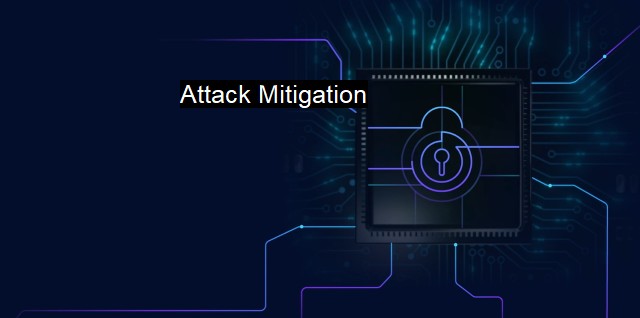What is Attack Mitigation?
Protecting Your System: The Essentials of Attack Mitigation in Today's Cyber Threat Landscape
Attack mitigation is a term prevalent in the cybersecurity industry that signifies dealing with the threats that loom over the cyber environment. it is the process of identifying, managing, reducing and eliminating risks in a system creature strategy devised to either prevent or diminish the severity of expected future threats that can compromise the security and integrity of networks/systems. In an era where digital technology is fundamental to most human activities, cybersecurity has emerged as one of the exigent subject matters.Given that the online world is thoroughly permeated with an assortment of destructive malware and sophisticated hacking techniques, a strategy must be in place against these online threats to prevent disruptions, damages or theft. This strategy is what is customarily dubbed as attack mitigation.
Attack mitigation involves a range of protocols and techniques, which give the system the agility to anticipate attacks, enveloping the diagnostic ability to recognize an attack, the resilience to survive the attack, and the potency to recover and restore its normal operational programs. it is a strategy designed to protect against an assortment of cybersecurity attacks including DDoS attacks, phishing scams, ransomware, spyware and intrusion.
Attack mitigation implementations start with setting up protective firewalls to block unauthorized access into a network system and installing sophisticated antivirus and antimalware software updates. Keeping software updated is a critical aspect of attack mitigation as it helps close loopholes and removes vulnerabilities in systems that attackers could potentially exploit. Antivirus software helps mitigate attacks by identifying and averting potential security threats preemptively. Considering that malware and viruses are constantly evolving to become more stealthy and sophisticated at infiltration, regularly updated antivirus tools are a cornerstone for attack mitigation.
Other preventive measures include intrusion detection systems (IDS) and intrusion prevention systems (IPS). These detection and prevention systems maintain constant vigilance through their ability to identify normal network traffic and detect abnormal activities that could potentially be malicious.
Effective attack mitigation also focuses on daily backups of vital data to an external server or cloud system, minimizing the potential harm of ransomware attacks by safeguarding essential personal or business files from being permanently lost. Creating a secure data backup enables timely recovery from an unexpected attack and helps keep business continuity intact.
Organizations today operate in geographically scattered locations, facilitating secure communication while dealing with sensitive information is a crucial part of attack mitigation. Encrypted communications protect data from being intercepted by hackers, thereby mitigating the risk of data theft. HTTPS secure connection, Virtual Private Networks (VPNs), and other encryption protocols are common methods of ensuring security in communication.
Employee training and cybersecurity awareness are commonly overlooked dimensions of cyberattack mitigation strategy. Since human error is often the weakest link in a security chain, educative programs about cyber risks, safe online activities and recognizing potential threats can significantly reduce the likelihood of successful attacks.
The promptness and efficiency of incident response strategy is a vital part of attack mitigation. This includes having a detailed, rehearsed, and operational response strategy to contain the impact, reduce damage and ensure quick recovery in case an attack occurs. Regular penetration testing emulates attacks to identify vulnerabilities in the system, providing an opportunity to rectify security glitches prior to becoming calamitous.
Attack mitigation isn't a choice; it's a necessity given the multiplicity and sophistication of cyber threats existing in the digital domain. creating a cyber-resistant environment requires a comprehensive and constantly evolving attack mitigation strategy to keep pace with technological advancements. With encompassing defensive mechanisms, robust backup and responsive recovery, the meticulously planned and executed attack mitigation strategy severs as a strong shield against malicious cyber-intended entities even in this era relentlessly marked by risky digital transformations.

Attack Mitigation FAQs
What is attack mitigation?
Attack mitigation is the process of reducing or preventing the impact of security threats on computer systems, networks, and applications. It involves identifying potential attacks, implementing security measures, and responding to incidents as they occur.What are the types of attack mitigation techniques?
Some of the common attack mitigation techniques include network segmentation, access control, encryption, firewalls, intrusion detection and prevention systems, anti-virus software, and security patches. Each technique addresses a specific aspect of security and can be implemented in combination to provide comprehensive protection.How can anti-virus software help in attack mitigation?
Anti-virus software is a critical component of attack mitigation as it can detect and remove malicious software before it has a chance to cause damage. It can identify viruses, worms, Trojan horses, and other types of malware by scanning files, email attachments, and downloads. Anti-virus software can also quarantine or delete infected files to prevent further spread of the malware.What are the benefits of attack mitigation?
Attack mitigation can help organizations minimize the potential damage caused by security threats. By identifying and addressing vulnerabilities in the system, attack mitigation can reduce the risk of data breaches, downtime, and financial losses. It can also improve the overall security posture of the organization, enhance customer trust, and ensure compliance with relevant regulations.| | A | | | B | | | C | | | D | | | E | | | F | | | G | | | H | | | I | | | J | | | K | | | L | | | M | |
| | N | | | O | | | P | | | Q | | | R | | | S | | | T | | | U | | | V | | | W | | | X | | | Y | | | Z | |
| | 1 | | | 2 | | | 3 | | | 4 | | | 7 | | | 8 | | |||||||